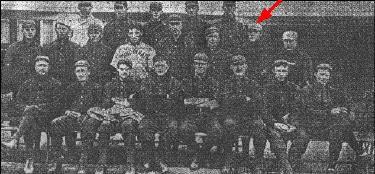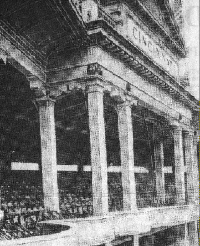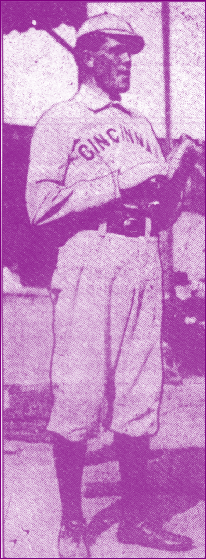This is
a picture of the 1903 Cincinnati Reds. Pitcher "Long Bob" Ewing, a native of New
Hampshire in Auglaize County,
is second from the right in the second row.

With springtime comes the sights and sounds of baseball, a
game still considered America's favorite pastime. Stories of Ohio's professional teams,
the Reds and the Indians, and their chances of success have begun to appear in local
newspapers. The age-old dream is once again ignited in many a young man. Can I make it to
the big time? The recent college baseball achievements of Sidney high school graduate
Derik Goffena have some Sidney sports enthusiasts talking about Goffena as a potential pro
prospect. Even at his level of achievement, the odds are still long. In fact, no Sidney
player has ever made the big leagues in over a century of organized baseball. Sidney did
play a role in the launching of the major league career of one of the best Cincinnati Reds
pitchers of all time. This is his story.
One hundred and twenty-five years ago this April, a baby boy was born in the small
Auglaize County village of New Hampshire. He was given the name of George Lemuel Ewing,
but everyone knew him as 'Bob'. By the time this young man had grown to his manhood height
of six feet six inches, he had acquired the nickname of 'Long Bob' Ewing. Later he would
also be given the moniker of 'Old Wapak', in reference to the town he called home.
Near the turn of the century, after the conclusion of the season, professional baseball
teams typically toured, or 'barnstormed' for a few weeks to generate interest among the
fans who could not attend the regular season games. So it was in 1901. After slicing
through a series of local Ohio teams like a hot knife through butter, the confident Reds
arrived in Sidney on October 10 for a contest with the Sidney semi-pro team.
Baseball was a serious local proposition in
those days. Town leaders first sponsored a Sidney team in 1893. During the next ten years,
a Board of Control was established to operate the team and raise funds on an annual basis.
The team's schedule included such far away road trips as Portsmouth, Canton, Lancaster,
Washington Court House, Columbus, and Parkersburg, West Va. Players were recruited from
Cincinnati, Dayton, Lancaster, Wapakoneta, and other towns.
As the Reds warmed up on the
evening of October 10, 1901, they could not have anticipated what they were about to see.
The visitors were up to bat first. On the mound stood all six feet six inches of Long Bob
Ewing. The next evening, the editor of the Sidney Journal described the game as a
"masterly exhibition of fine ball playing." Hundreds of fans crowded in
to watch the contest, which was held at the South Miami Avenue Ball Grounds (This location
is now known as Berger Park.)
Ewing dueled Schwab, his Reds counterpart, to a 3 to 3 tie when the game was called
because of darkness after eight innings. The author of the Journal article
concluded: "The country has few pitchers equal to Ewing, who struck out many more
batters than Schwab..." Apparently the Reds players felt the same way. At the
beginning of the 1902 baseball season, Long Bob was wearing a Cincinnati Reds uniform. In
a round about way, Sidney had produced its first major leaguer. In the end, Ewing became
more that just a player. Nearly a century after his last game, his statistics qualify him
as one of the best Reds hurlers of all time.
Ewing the pitcher had actually been a long time in the making. He started on the
sandlots of Wapakoneta in 1895, and played his first game against a team from nearby New
Bremen. Chris Ewing, one of his eight surviving grandchildren, recalls family folklore
about his grandfather's efforts to learn the art of pitching: "Grandfather worked
on the family farm as a young lad, helping raise potatoes. One day his parents discovered
much of the potato crop was bruised. An investigation revealed that their son was hurling
the spuds at a circle on the side of the barn, in an effort to improve his control as a
pitcher."
His first semi-pro experience came in 1897 when he joined the Toledo team in the
Interstate League. He was consistently the best pitcher in the league, going 21-9 and
25-13 in consecutive seasons. His next stop was with Kansas City in the Western League.
Ewing later recalled that Kansas City was "...the only pennant winning team I ever
played on."
Apparently, Long Bob had concluded his season with Kansas City when he joined the
Sidney team and took advantage of the opportunity of his life on that October, 1901
evening in Sidney. The Cincinnati Reds had just completed a new playing field when Ewing
arrived in 1902. It was affectionately known as the 'Palace of the Fans'. This stadium,
which served as the home of the Reds until the construction of Crosley Field at the same
site, was one of the most modern and futuristic parks of the era. (It is interesting to
note that spring training was held at the Palace in 1902 - one of eight different cities
where the Reds held spring training in Ewing's eight seasons.)
The debut of Long Bob Ewing at the Palace was
on April 10, 1902. The next week's edition of the Shelby County Democrat carried
the results in an article entitled: 'Bob's Good Start.' Ewing pitched the better part of
two innings, striking out four of the eight men he faced. The author proudly reported that
Bob "...further added to his laurels by bringing in two runs with a hard drive
while at the bat." A future star had been born.
After working his way into the
starting lineup that first season, Ewing finished with a 6 and 6 won-lost record. He
pitched ten complete games in twelve starts and compiled a fine 2.98 earned run average. A
sore arm limited his playing time toward the end of the season.
In 1903, Long Bob developed into the workhorse of the staff. Completing 27 of the 28
games he started, Ewing posted 14 wins and lowered his ERA to 2.73. He delivered at the
plate as well. That season, Ewing hit an impressive .253.
The season's highlight came on August 18. The headline in the "Cincinnati
Post" told the story: "Kelley Claims Ewing Pitched a No-Hitter" He
blanked the New York Giants 7 to 0, giving up one infield hit, and it was a hotly disputed
one at that. The official scorer recorded the play as an out, but was ordered to score it
as a hit. A dispatch from New York after the game stated: "Long Bob Ewing, fed on
raw meat and clams for a week, was taken out of his cage and sent against the Giants...Old
Wapak fired the leather down the alley so fast that the haze in its wake looked like the
smoke in a shooting gallery." A seasoned and confident Bob Ewing barnstormed with
the Reds after the season concluded.

Above is the Palace of the Fans
— home to the Cincinnati Reds in the early 1900s. Ewing made his debut in The Palace
on
April 10, 1902, and struck out four of the eight men he faced. He also drove in two
runs that day.
During Ewing's hiatus from Sidney, the locals
developed a serious love for the nation's past time. The April 25, 1902, edition of the Sidney
Journal reported the construction of a new ball diamond known as Lakeside Park. (It
was situated where the municipal pool is now located in Tawawa Park.) Three inches of clay
were brought in and rolled with the city's street roller to cover what would be the ball
diamond. The editor also noted: "The outfield was cleared of all obstructions."
It was a confident Cincinnati crew that rolled into town for a rematch with Sidney on
September 30, 1903. Long Bob was on the mound for Reds, which had just pummeled Lima 9 to
1 the day before. This would be a laugher. After the game the "Journal's"
editor, William Binkley, wryly observed that the Reds came to town to show "...what
a difference there is between a professional team and pumpkin puller aggregations in
smaller towns...and to prick what bubbles of vanity they entertain." After Long
Bob took his seat at the end of the first inning, Sidney led 5 to 1. Binkley chortled:
"The Reds were amazed, and in a figurative sense, more blue than red."
It was just one of those nights. The Reds outfielders were "as busy as a cow's
tail in fly time," according to Binkley, while Sidney's infielders "guarded
the infield like watch dogs fed on electricity." In the end, Long Bob and the
Reds absorbed a 14 to 2 beating. Mr. Binkley appropriately summed up the event: "In
short, the Reds were outclassed, the spectators were given a treat of rare sport, and the
visitors gracefully acknowledged the corn."
Championship athletes do not get mad, they get even. The Reds returned to Sidney the
next year for what the Wapakoneta newspaper described as "Ewing Day in Sidney."
Fifty wagons circled the court square, and banners proclaiming 'Ewing Day' were hung
everywhere. A local baker sold 'Ewing pies' and bartenders served 'Ewing highballs.' Two
thousand fans jammed the ball field. As the first Sidney batter whiffed, the crowd
screamed: "Don't throw so hard, you'll kill the catcher!" Ewing and the
Reds prevailed, 6 to 1.
Long Bob turned in six more sparkling seasons with Cincinnati. In professional baseball
after the turn of the century, the spitball was a legal pitch, and Ewing had one of the
best in the majors. Long Bob must have been an intimidating sight at six feet six inches
with a pitch that danced all the way to the plate. A newspaper writer of the era described
him as also having "great speed and a puzzling drop curve."
Long Bob won 20 games in 34 starts with only 11 losses during the 1905 season. He still
batted over .250. During that season, he married Nell Hunter, whom the society pages of a
Cincinnati paper described as being a "handsome and clever society girl."
She was an avid baseball fan in her own right. Beginning in the 1890s, she attended what
was at the time a major league record of more than 60 straight opening day games of the
Reds. She had equal measures of loyalty and superstition, however. Nell watched several
games in 1905 that her husband lost. After that, she refused to go to the park when Ewing
pitched, claiming her presence would 'hoodoo' him, according to the newspaper accounts.
During the next two seasons, he was destined
to pitch his best ball. With a minuscule ERA of 2.38 and almost 300 innings pitched in
1906, one would expect a sparkling won-lost record. Poor run support by his teammates
resulted in only a 13-14 record for the right hander.
The 1907 season belonged to Long
Bob. He was outstanding. The highlight of the season came early when he was handed the
ball for opening day. The opponent was the Pittsburgh Pirates, led by the immortal future
hall of famer Honus Wagner. Ewing pitched a complete game, four hit, 4 to 3 victory. In
what he always viewed as the highlight of his career, Ewing fanned the first six Pirate
batters he faced, including such outstanding hitters as Wagner, Fred Clark, and Clarence
Baumont. The Cincinnati Enquirer reported that "He used the spitball when
he found himself in a tight place and it was very effective in his hands." The Shelby
County Democrat carried an account of the game which concluded: "Ewing's many
friends in Sidney extend congratulations and wish him success throughout the season."
Long Bob did his best to ensure his own success in 1907. Pitching over 330 innings, he
compiled a career-best ERA of 1.73, and averaged almost twice as many strikeouts as bases
on balls. Although he won 17 games, little offensive help from his teammates resulted in
19 losses. Ewing accomplished all this at the age of 34 that year.
Bob Ewing concluded his career with the Reds after the 1909 season. In his eight year
stint with the Cincinnati club, he compiled an overall earned run average of 2.37. Almost
90 years later, it still stands as the best Reds' career ERA record ever compiled.
Ewing was traded to Philadelphia, where he played in 1910 and 1911. He won 16 games in
1910, hurling one two-hitter and two three-hitters. By the start of the 1912 season, he
was traded to St. Louis. Now 39 years old, Long Bob appeared in just one game. He
concluded his career in 1913 by playing part of the season for Minneapolis of the American
Association. However, he was destined to have one more experience with Shelby County
baseball.
While on a short leave from Minneapolis, 'Old Wapak' agreed to pitch two games for his
hometown team, the Wapakoneta Reds. He had just turned forty years old when he took the
mound to face the Findlay semi-pro team on May 17, 1913. Five hundred paying fans saw
Ewing strike out twelve batters while strolling to a 10 to 0 win. The most important game
was to follow, for next up was Wapak's dreaded arch rival, the Botkins Reds.
To turn the pressure up a notch on Botkins, Wapak declared game day to be 'Ewing Day'
in town. As he stepped in for his first at bat, time was called, and Ewing was presented
with a horn-grip, gold-mounted umbrella engraved "Bob, 1913." The crowd
cheered lustily. Ewing struck out. Wapak eked out a 4 to 3 win. It was Long Bob's last
local pitching appearance.
After hanging up his baseball
spikes, Ewing returned to his off-season occupation of farming. He was an expert horseman
as well, raising trotters which competed in races throughout the Midwest. Bob Ewing was
elected to two terms as the Auglaize County Sheriff, and later ran the Brunswick Cigar
Store in Wapak. He died in June, 1947, at 74 years of age. Almost 90 years after leaving
the Reds, his pitching feats qualify him as one of the best Reds hurlers of all time. Only
three Reds pitchers completed more games in their career than Ewing. His Reds career ERA
record of 2.37 is the best ever for a Red and ranks 28th on baseball's all time list.
Despite these impressive credentials, he has never been elected into the Reds' Hall of Fame.
A Cincinnati sportswriter in 1908
summed him up as follows: "Ewing is one of the most faithful and conscientious
players in the business, always ready to do his part and then some. He has always taken
perfect care of himself. Long Bob is a credit to the Cincinnati team and the national
game."
His seven surviving grandchildren agree. Florida resident and grandson Chris Ewing said
it best. "Grandpa was admired as a great pitcher, but respected even more as a
person. That is what makes us most proud of him."

Pitcher "Long
Bob" Ewing, a native of New Hampshire in Auglaize County, warms up
for the Cincinnati
Reds in this 1903 photo.
Update on Long Bob Ewing
This
information is excerpted from an article that appeared in The Sidney Daily News on April 29, 1999, written by Sports Editor, Ken Barhorst
"It was a bit of a disappointment for members of the Shelby County Historical
Society when they learned that the Cincinnati Reds would be inducting only one person into
their Hall of Fame this year. But one member’s suspicions about why, when the normal
procedure calls for two per year, turned out to be true. That one inductee will be Sparky
Anderson, who managed the "Big Red Machine" that won back-to-back World Series
titles in 1975 and ‘76.
The Historical Society has been in almost constant contact with the Reds trying to get
"Long Bob" Ewing inducted into the team’s Hall. "I got a call from
Ritter Collet (retired sports editor of the Dayton Daily News), " said
Dave Ross, one of the key players in the Historical Society’s bid. "He
confirmed that my suspicions were correct. When Sparky was chosen, they decided he stood
on his own. Normally, they pick two, one from 1970 or after, and one that preceded the Big
Red machine."
But Ross added that from his conversation with Collett, he feels as confident as ever
that it won’t be long before Ewing’s name is added to the Hall of Fame list in
Cincinnati. "I feel very confident that Long Bob Ewing will be the first player
considered next year when they look at a player from that era," he said.
Ross said the local Historical Society envisions holding a ceremony at Berger Park when
Ewing is finally named. And he’d like to see a monument erected similar to the one
that now sits as Orbison park, commemorating the first Sidney High football game at the
site. The inductees are chosen by the Cincinnati Chapter of the Baseball Writers of
America, with the Reds’ endorsement."
[ Back to Sports Index ] |

